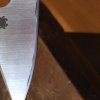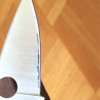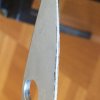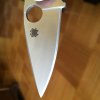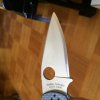Hello, this is the story: I bought a new Native 5 CF S110V two months ago. I used it with the original edge and then I need to give it a resharpening.
I used the Sharpmaker with diamond rods at 30° and I noticed that right bevel was becoming much more width then the other. The worst thing was that bevel started to becoming convex too and wasn't possible to obtain a really sharp edge!! I measured the angles on my Sharpmaker's rods and they are 14.5 and 15.5, not enough to create the problem (and is the same Sharpmaker I use for all my knives with good results). Then I rebeveled the blade for a lot of times (I have almost consumed 2-3 mm of the blade in order to solve the problem) but what I can only obtain is one perfect bevel and the other convex and with a rough edge. And the blade is not sharp!!!
Any opinion? Thanks!!
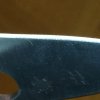
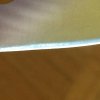
I used the Sharpmaker with diamond rods at 30° and I noticed that right bevel was becoming much more width then the other. The worst thing was that bevel started to becoming convex too and wasn't possible to obtain a really sharp edge!! I measured the angles on my Sharpmaker's rods and they are 14.5 and 15.5, not enough to create the problem (and is the same Sharpmaker I use for all my knives with good results). Then I rebeveled the blade for a lot of times (I have almost consumed 2-3 mm of the blade in order to solve the problem) but what I can only obtain is one perfect bevel and the other convex and with a rough edge. And the blade is not sharp!!!
Any opinion? Thanks!!



